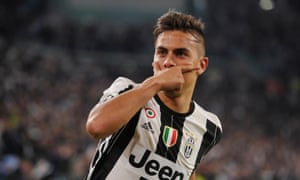The 23-year-old Argentinian forward, an immensely talented player with ‘PlayStation moves’, will be key as the Italian side take on Monaco in the Champions League semi-final
His more usual nickname, la Joya – “the Jewel” – was given to him by an Argentinian journalist after he scored in his second game for the Cordoba side Instituto when he was 17, taking the record for the club’s youngest goalscorer from Mario Kempes. But really, like so many Argentinians, his is an immigrant’s story and begins long before he was born.
Dybala’s grandfather, Boleslaw, grew up working for a priest in Krasniow, a village in southern Poland about 40 miles north-east of Krakow. During the second world war he was sent to work in Germany. When he returned home he found there were no jobs so decided to emigrate to Argentina. He knew nobody there, had no connections and spent the first two weeks sleeping in a cornfield before finding work. His brother went to Canada and would send him a card and a communion wafer every Christmas. Boleslaw had forgotten his Polish and had to have the letters translated.
Boleslaw died when Dybala was four but the impression he made on his grandson remains strong. When Dybala left Instituto for Palermo in 2012 and needed a European passport, he initially tried to take Polish citizenship. The bureaucracy involved, though, proved too complicated and he instead applied for an Italian passport through his mother’s side of the family, which is from near Naples.
At first Dybala was an enganche, the play-making “hook” linking midfield and attack, but his interpretation of the role was never conventional. As his strike partner in the youth ranks at Instituto, Gustavo Gotti, recalls, there was always a maturity and an efficiency about the way he played. “They say that when you’re a kid a great player will go past 10,” Gotti said. “Not him. He cleaned out one and then gave you the right pass. He played fast, simple – he made a difference with shots from outside the area. A little like what he does now.”
It was in 2011 when the real breakthrough came. Instituto’s youth side went to play in the Torneo Esperanza Alba, a competition organised by Colo Colo in Santiago, Chile, and their coach, Francisco Buteler, decided to push Dybala forward alongside Gotti. At first he was reluctant, seeing himself in the great Argentinian tradition of No 10s, but by the end of the year he was playing for the first team and had become la Joya.
That awareness of both roles is key to Dybala, who can play either as an out-and- out striker or off a front man. In that sense he is a very modern player, a complete forward, a dribbler who dribbles only sparingly. The Uruguayan former Manchester United forward Diego Forlán has compared him to Agüero, which seems more accurate than the inevitable description of him as “the new Messi”.
But if he is like Agüero, it is Agüero as he was playing alongside Forlán at Atlético when he was much more likely to drop deep than he is now. Dybala is probably not such an instinctive finisher as his compatriot but his range of movement and of attributes is probably greater. In that sense he is the player it looked as if Agüero might become, the player Pep Guardiola would seemingly like Agüero to be, rather than the fairly orthodox (and highly effective) forward Agüero now is.
Against Monaco on Wednesday in the first leg of the Champions League semi-final, it seems probable that Dybala will play behind Higuaín. The partnership, with Mario Mandzukic to one side and Juan Cuadrado to the other, has proved highly effective this season but it could also be a template for Argentina to follow.

Nenhum comentário:
Postar um comentário